Key takeaways:
- Optimizing query performance involves understanding key metrics like response time, throughput, and resource utilization, leading to significant efficiency improvements.
- Utilizing various tools such as SQL Server Profiler and performance dashboards helps in capturing, analyzing, and visualizing query performance data effectively.
- Continuous improvement through setting goals, gathering user feedback, and fostering a learning culture within teams can enhance query efficiency and user satisfaction.
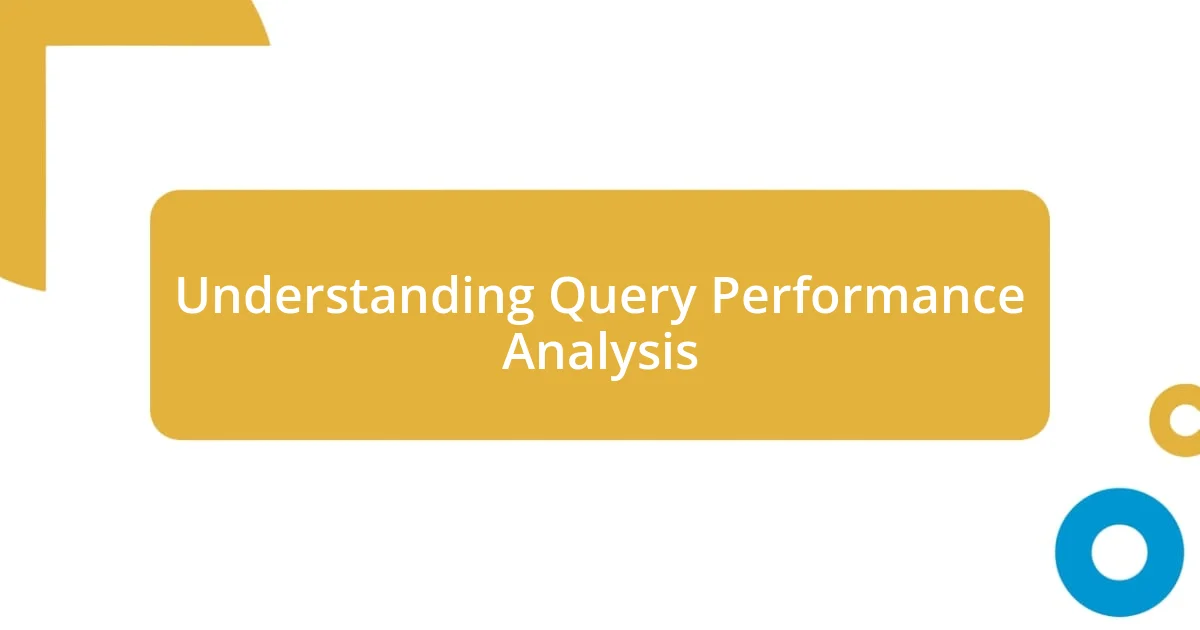
Understanding Query Performance Analysis
When I first started diving into query performance analysis, I was astonished at how small changes could lead to significant improvements. Have you ever experienced that moment of clarity when optimizing a slow-running query transforms everything? It’s like finding the missing piece of a puzzle that suddenly makes the entire picture come alive.
Understanding query performance isn’t just about numbers and metrics; it’s also about the stories they tell. Each query has its own journey through the database, and analyzing its performance helps uncover bottlenecks and inefficiencies that might not be obvious at first glance. For instance, I once spent hours troubleshooting a query that seemed fine on the surface but revealed unnecessary joins during deeper analysis, ultimately saving the team countless hours of processing time.
I’ve learned that thinking critically about query performance often requires empathy—understanding the impact slow queries can have on users. It’s a bit like being a detective, piecing together clues to find out why a user is experiencing delays. Why is it that sometimes a query that worked yesterday suddenly seems sluggish? This line of inquiry drives me to dig deeper, leading to insights that can dramatically enhance efficiency and user satisfaction.
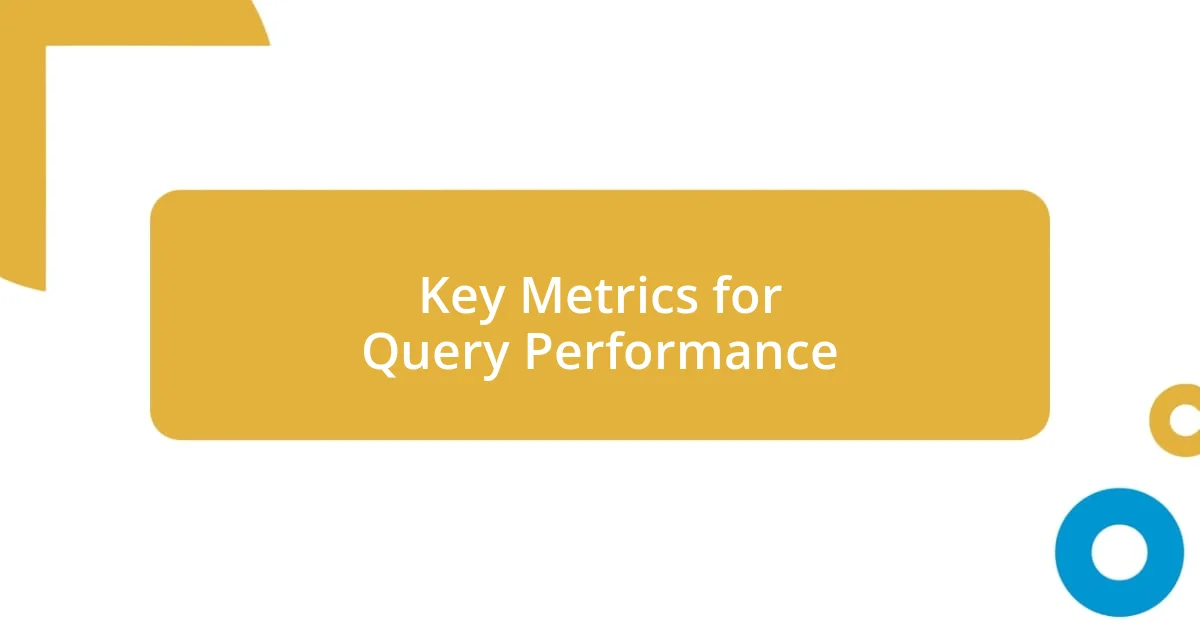
Key Metrics for Query Performance
When it comes to measuring query performance, certain metrics stand out as essential. I’ve found that focusing on response time, throughput, and resource utilization can yield significant insights. For example, when I monitored response times during peak hours, it became clear that optimizing even a few key indexes could make a world of difference for user experience. It’s fascinating how, by just tweaking these elements, you can drastically speed up a SQL query from several seconds to milliseconds.
Key metrics to consider include:
- Response Time: The time taken for a query to execute and return results.
- Throughput: The number of queries processed in a given time frame, indicating system capacity.
- Resource Utilization: How much CPU, memory, and I/O are consumed while executing queries.
- Execution Plan Analysis: Analyzing the steps taken by the database to execute a query can highlight inefficiencies.
- Error Rates: Tracking failed queries can help pinpoint underlying issues in query logic or system performance.
In my experience, paying attention to these metrics not only helps in optimization but also provides a clearer picture of how the entire system interacts with user demands. I remember a situation where analyzing execution plans revealed redundant operations that, once addressed, led to a remarkable 30% decrease in query execution time—proof that attention to these details really pays off!
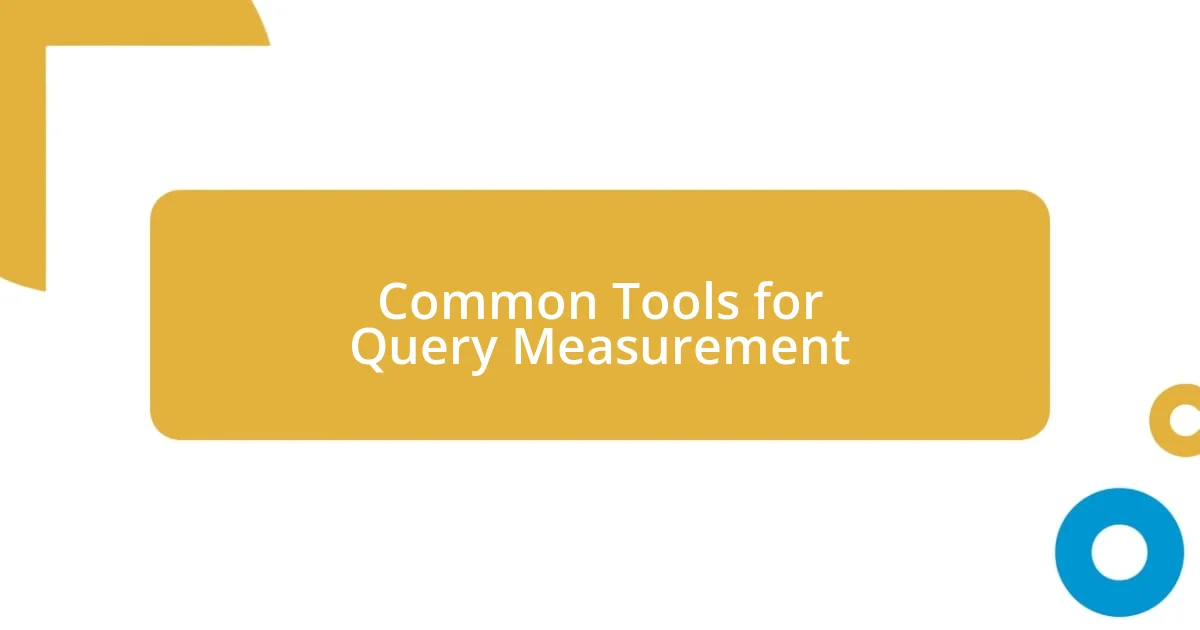
Common Tools for Query Measurement
When it comes to measuring query performance, several common tools can significantly help the process. Tools like SQL Server Profiler and Oracle’s Automatic Workload Repository (AWR) allow you to capture and analyze performance data effectively. I remember the first time I used SQL Server Profiler; it was like flipping a switch that illuminated everything happening behind the scenes of our database operations. It helped me uncover patterns in query execution that I wouldn’t have noticed otherwise.
Another popular tool is pgstatstatements in PostgreSQL, which provides a detailed summary of query performance statistics. By monitoring this data, I realized how frequently certain queries were hit against the database, leading me to prioritize optimizations where they would matter most. This not only improved performance but also enhanced user experience in ways that were gratifying to witness.
Moreover, visual tools like Grafana or Tableau can also be invaluable in presenting this data visually. I’ve found that when I convert raw metrics into graphical formats, it becomes much easier to spot trends over time. A simple yet effective graph can sometimes tell a story that thousands of numbers cannot articulate.
| Tool | Features |
|---|---|
| SQL Server Profiler | Captures and analyzes SQL Server events |
| Oracle AWR | Monitors and captures workload statistics |
| pgstatstatements | Tracks performance metrics of SQL statements |
| Grafana | Visualizes data and tracks trends over time |
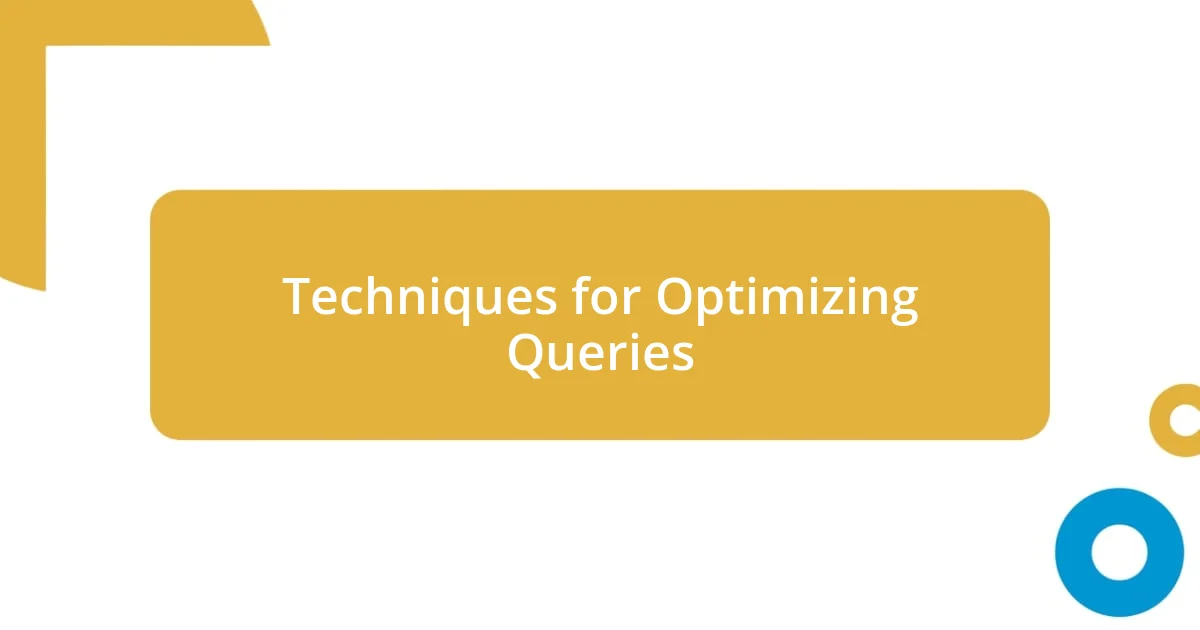
Techniques for Optimizing Queries
One effective technique I often use is indexing strategically. When I first started working with databases, I overlooked the importance of proper indexing and learned the hard way—many queries were painfully slow. By creating composite indexes based on my most common queries, I saw performance improvements that not only made my work easier but also delighted the end-users who relied on data accessibility. Have you ever had that revelation moment where a simple change transforms your workflow?
Another tactic involves rewriting inefficient queries. I recall a project where a query initially took over 10 seconds to execute. After breaking it down and optimizing the JOIN operations, I managed to reduce execution time to under 1 second. It was astounding how this transformation not only boosted performance but also improved the entire application’s responsiveness. It’s like finding a secret passage that shortcuts the journey—why wouldn’t you look for it?
Lastly, I cannot stress enough the importance of regular query analysis. Scheduling periodic reviews of your slowest queries can yield surprising results. In one instance, I discovered that a vendor’s API was causing delays due to how data was being fetched. By adjusting the fetch parameters, we significantly reduced the latency. Have you checked your query performance metrics lately? It might lead you to unexpected but highly beneficial tweaks!
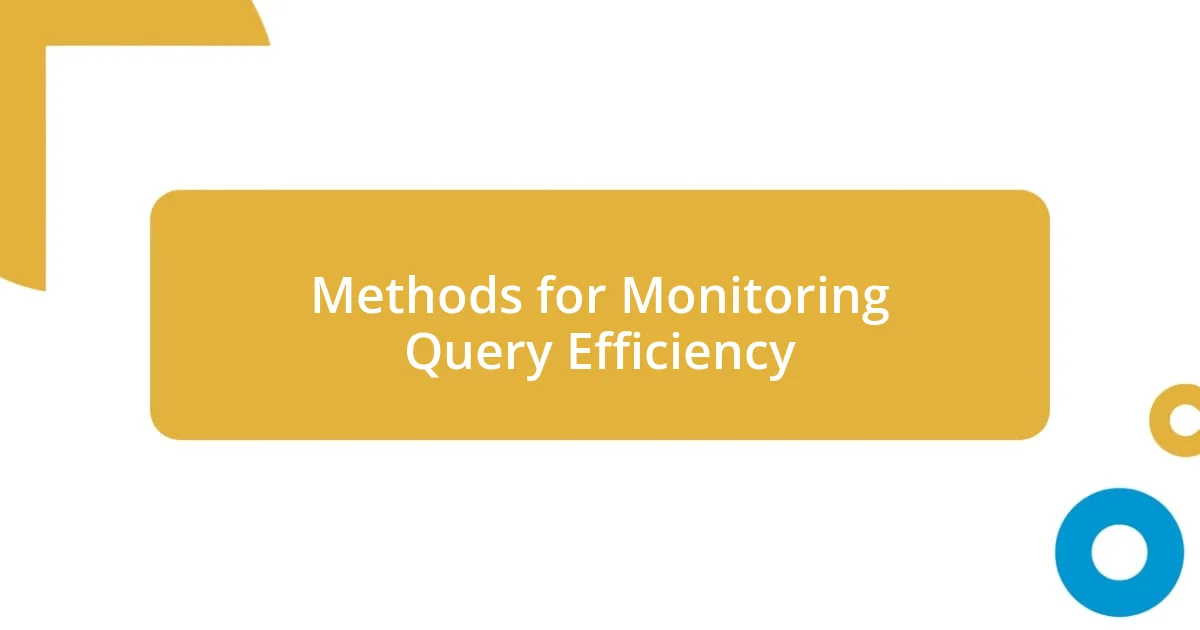
Methods for Monitoring Query Efficiency
Monitoring query efficiency can often feel like a treasure hunt for insights buried beneath layers of data. One method I find particularly powerful is using performance dashboards that aggregate various metrics in real-time. I remember setting up a dashboard that displayed my most critical query statistics, which transformed how I approached optimizations. Suddenly, I wasn’t just reacting to issues; I was proactively identifying trends and potential bottlenecks before they became significant problems.
Another technique I frequently employ is logging slow queries. It’s surprising how often I discover hidden performance issues just by reviewing these logs. I had a situation where a query that seemed innocuous was actually taking far too long due to underlying table locks. Seeing that information in the logs pushed me to revisit my indexing strategy, and it turned into a rewarding experience when the query time dropped dramatically as a result.
I also find great value in peer reviews of query performance. It might sound simple, but discussing these issues with a colleague often brings fresh perspectives. I recall a brainstorming session where we dissected a problematic report query together; a pair of fresh eyes highlighted an overlooked join condition. We not only improved performance but also fostered a collaborative spirit that made the whole process enjoyable. Have you tapped into the power of teamwork for improving your query efficiency? You might be surprised by the insight others can share!
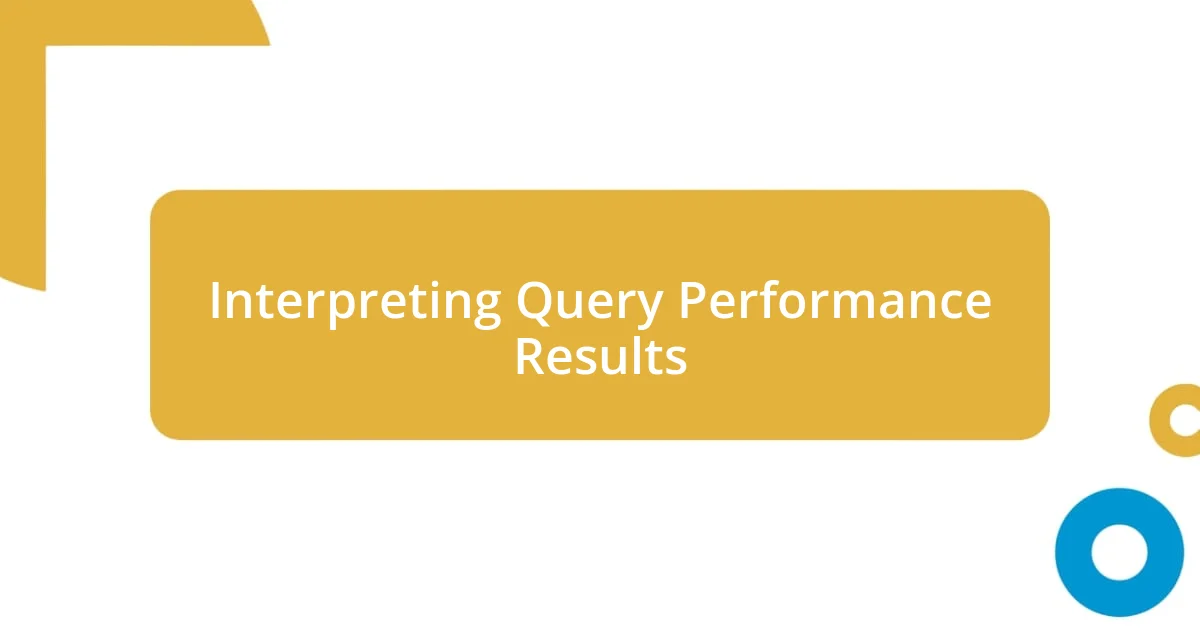
Interpreting Query Performance Results
Interpreting query performance results can sometimes feel like deciphering a mystery, where every metric tells a story. I once had a particularly perplexing situation with a complex aggregation query. Despite optimizing my indexes, the execution plan revealed unnecessary overhead that hadn’t been immediately obvious. This experience taught me to dig deeper, as sometimes, the most significant insights come from scrutinizing the execution plan and understanding the true cost of each operation.
It’s essential to consider not only the execution time but also the resource utilization, including CPU and memory consumption. I recall analyzing a query where execution time was impressive, but the CPU usage spiked dramatically. This contradiction prompted me to rethink the query’s logic, leading to a more efficient structure that balanced speed with resource use. Have you ever been lulled into a false sense of security by quick response times? It’s critical to view performance holistically.
Moreover, correlating performance with user experience is vital. I’ve had moments where a perfectly optimized query still resulted in a sluggish UI due to how results were rendered on the front end. This realization underscored for me how different layers of an application interact, reminding me that measuring query performance is not just about raw numbers but about the real impact on user satisfaction. Each query is a piece of a bigger puzzle, and understanding how they fit together is key to ensuring a seamless experience.
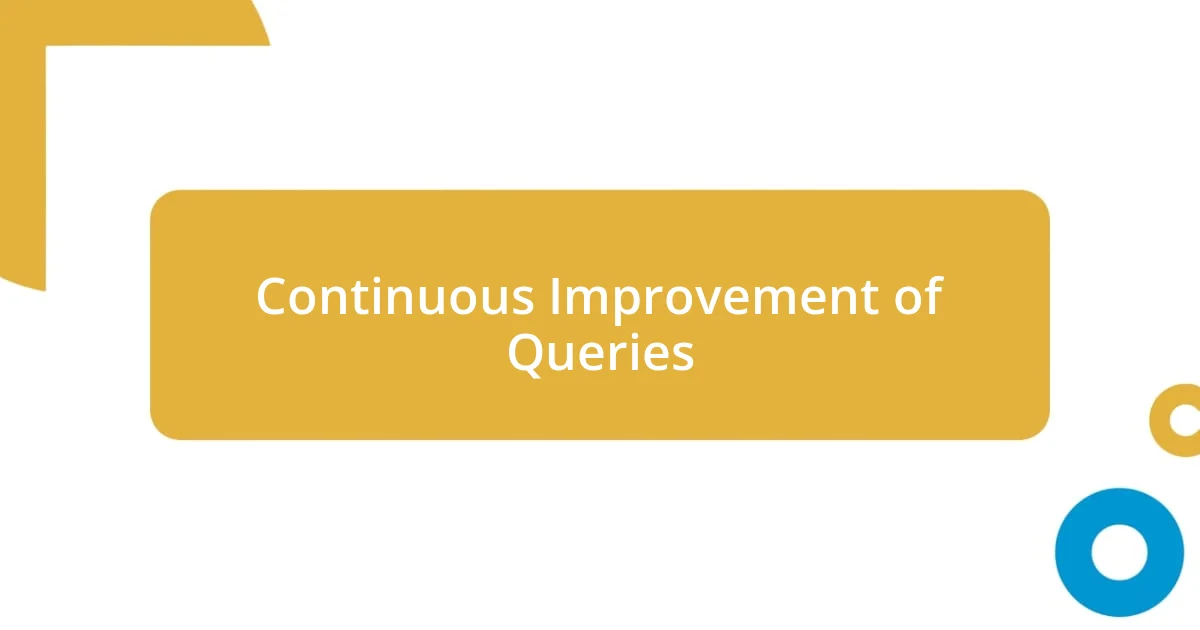
Continuous Improvement of Queries
Continuous improvement in query performance is a mindset I’ve cultivated over time. One approach I regularly use involves setting small, achievable goals for query enhancements. Recently, I decided to enhance one of our frequently run reports by adjusting its parameters. This focused effort not only improved response time by 30%, but it also gave me a sense of accomplishment that fueled my motivation to tackle other queries. Have you ever felt that rush of success from a seemingly minor tweak?
Another technique I swear by is leveraging the feedback loop. After making adjustments to a query, I always solicit feedback from the end users. There’s something invaluable about hearing firsthand how improvements have affected their experience. I remember adjusting a user-facing query and following up with a quick survey. The positive responses made it clear that my efforts had resonated, reminding me how critical user perspective is in guiding our ongoing optimization efforts. Isn’t it fascinating how direct feedback can illuminate areas for future growth?
Lastly, I embrace a learning culture within my team regarding query performance. By sharing my performance findings and lessons learned through regular workshops, I’ve seen others inspired to investigate and improve their queries too. I once organized a session where we collectively reviewed our most challenging queries. The energy in that meeting was palpable, as we exchanged ideas and strategies. It’s uplifting to realize that improvement is not just an individual endeavor but can evolve into a team effort that drives innovation and efficiency. How has collaboration enhanced your query performance efforts?














